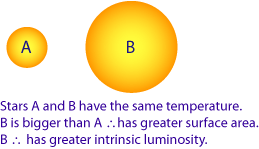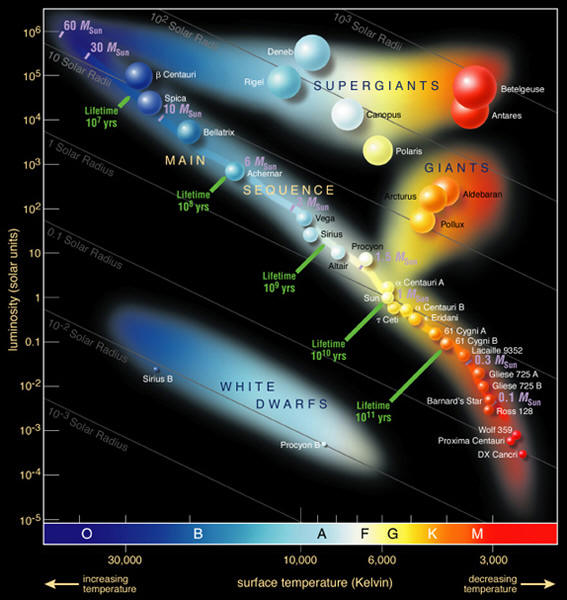Dits brightness at a hypothetical distance. Earth Sciences questions and answers.

Luminosity And The Distance To Stars
For example the luminosity of Sirius is about 25 times that of the Sun.
. The most common stars are best described on the HR diagram as. In a later chapter we will see that if we can measure how much energy a star. How it appears from Earth how bright it would appear from a standard distance and how much energy it emits.
The Mass-Luminosity Relationship As shown in the graph above the brightness of Main-Sequence stars varies proportional to some power of their masses. Basically for example if a star is 8300 degrees Celsius and has a luminosity of 0001. Decreasing luminosity at constant temperature then increasing temperature at constant luminosity.
For each statement or question choose the word or expression that of those given best completes the statement or answers the question. Cits total energy output into all space over all wavelengths. Approximately the same luminosity as a white dwarf.
10M 5M 1M 05M. Answer all questions in this part. The luminosity of this star can best be described as Less than the luminosity of the sun As altitude increases in the troposphere and stratosphere the air temperature.
Less than the luminosity of the Sun. What do neonoxygen and nitrogen have in common. High luminosity High temperature stars.
Most of the stars are white or red. Bits brightness as seen by people on Earth. The evolution of a star can be described in terms of changes in its temperature and luminosity which can best be followed by plotting them on an HR diagram.
The sun illuminated the streets and caused temperatures to rise. The luminosity of this star is 170 times the solar luminosity. There is a mathematical relationship that relates these three quantitiesapparent brightness luminosity and distance for all light sources including stars.
In fact the sun is unremarkable. Early philosophers considered the sun to be special. For most of the range of stellar masses the proportionality is as the 35 power of the mass which means that if the mass doubles the luminosity increases by about 11 times or rounding off a.
Which of the following is a trend among the main sequence stars. Some questions may require the use of the 2011 Edition Reference Tables for Physical SettingEarth Science. Luminosity of Star R 2 x T 4.
The sun is considered a star because it has all the characteristics of one. Part B - 1. 43 The luminosity of this star can best be described as 1 less than the luminosity of the Sun 2 greater than the luminosity of most stars in the main sequence 3 approximately the same luminosity as a white dwarf 4 approximately the same luminosity as Aldebaran.
Its power was obvious. To make the comparison among stars easy astronomers express the luminosity of other stars in terms of the Suns luminosity. Directions 36 - 50.
Aless than the luminosity of the Sun Bgreater than the luminosity of most stars in the main sequence Capproximately the same luminosity as a white dwarf Dapproximately the same luminosity as Aldebaran 36The luminosity of this star can best be described as Acontact metamorphism Binternal crystallization Cnuclear fusion Dradioactive decay. Protostars generate energy and internal heat through gravitational contraction that typically continues for millions of years until the star reaches the main sequence. We use the symbol L Sun to denote the Suns luminosity.
Aless than the luminosity of the Sun Bgreater than the luminosity of most stars in the main sequence Capproximately the same luminosity as a white dwarf Dapproximately the same luminosity as Aldebaran 36The luminosity of this star can best be described as Acontact metamorphism Binternal crystallization Cnuclear fusion Dradioactive decay. Answer all questions in this part. Directions 1 - 35.
Earth Science - New York Regents January 2016 Exam. A stars luminosity is measured according to the relevance to the sun. The larger stars emit light that is blue.
Low luminosity Low temperature stars b. Hence that of Sirius can be written as 25 L Sun. The luminosity of a star is.
High luminosity Low mass stars c. The evolution of a solar mass star on the H-R diagram can best be described as. The luminosity of this star can best be described as.
Which of the following protostars will reach the main sequence the fastest. The brightness of a star is measured several ways. Greater than the luminosity of most stars in the main sequence.
In addition look at this image. Arcturus star is the brightest star in the constellation Bootesand fourth brightest star in he night sky. There are countless stars with the same attributes as the sun throughout the universe.
For each statement or question choose the word or expression that of those given best completes the statement or answers the question. The more massive the protostar the faster it evoles. Stars dimmer than the Sun are of class O or B.
Aanother name for its color or surface temperature. Hubble Space Telescope image of star cluster 47 TucanaeAstronomers took images through different colored filters in this case near-infrared I visual V and ultraviolet U and added the three images together to produce a close approximation of the colors we would see of these stars with our own eyes. The evolution of a star can be described in terms of changes in its temperature and luminosity which can best be followed by plotting them on an HR diagram.
L 2 4 2 x 2 x 2 x 2 16 times the suns luminosity. The luminosity of this star can best be described as. Approximately the same luminosity as Aldebaran.
Protostars generate energy and internal heat through gravitational contraction that typically continues for millions of years until the star reaches the main sequence. The HR Diagram categorizes stars by surface temperature and. What would we expect the number of chromosomes in a normal cell to be.
Low luminosity High temperature stars d. The hotter the star the more brightly it burns. An intrinsically faint nearby star can appear to be just as bright to us on Earth as an intrinsically luminous distant star.

Use The Hertzsprung Russell Diagram Shown To Match Each Star Type To The Correct Description Brainly Com

0 Comments